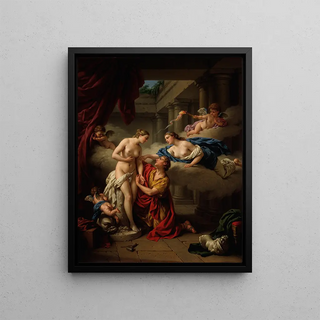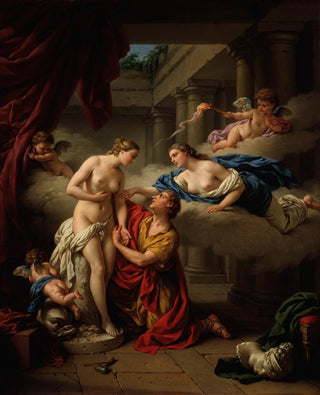Art print | Pygmalion and his statue - Louis-Jean-François Lagrenée


View from behind

Frame (optional)
Louis-Jean-François Lagrenée’s "Pygmalion and his statue" art print immerses us in a universe where mythology meets artistic creativity. This iconic scene, inspired by the Greco-Roman myth, evokes the renowned sculptor Pygmalion, whose love for his own creation comes to life before our eyes. The depiction of this passionate love and the ideal beauty of the statue, which seems almost animated, invites viewers to reflect on the relationship between the artist and their work. Lagrenée, with his technical mastery and sensitivity, manages to capture this magical moment, where art transcends matter to touch the very essence of humanity.
Style and uniqueness of the art print
Lagrenée’s style is distinguished by remarkable delicacy and meticulous attention to detail. In "Pygmalion and his statue," the composition is carefully orchestrated, with each element contributing to the harmony of the whole. The drapery of the clothing, facial expressions, and texture of the statue are rendered with precision that demonstrates refined technique. Light plays a crucial role in the art print, emphasizing contours and creating shadows that add depth to the scene. This focus on light and color, typical of the rococo style, gives the piece a dreamy and romantic atmosphere. Lagrenée succeeds in establishing a dialogue between reality and imagination, offering a visual experience that goes beyond mere observation.
The artist and his influence
Louis-Jean-François Lagrenée, an emblematic figure of the 18th century, established himself in the art world through his talent and unique vision. Raised in an artistic environment, he was influenced by the great masters of his time, while developing a personal style that is distinctly his own. His works, often imbued with mythological themes, are characterized by elegance and sophistication that captivate both audiences and critics. Lagrenée also played an important role in transmitting the aesthetic values of his era by integrating elements of classical culture into his creations. His work

Matte finish

View from behind

Frame (optional)
Louis-Jean-François Lagrenée’s "Pygmalion and his statue" art print immerses us in a universe where mythology meets artistic creativity. This iconic scene, inspired by the Greco-Roman myth, evokes the renowned sculptor Pygmalion, whose love for his own creation comes to life before our eyes. The depiction of this passionate love and the ideal beauty of the statue, which seems almost animated, invites viewers to reflect on the relationship between the artist and their work. Lagrenée, with his technical mastery and sensitivity, manages to capture this magical moment, where art transcends matter to touch the very essence of humanity.
Style and uniqueness of the art print
Lagrenée’s style is distinguished by remarkable delicacy and meticulous attention to detail. In "Pygmalion and his statue," the composition is carefully orchestrated, with each element contributing to the harmony of the whole. The drapery of the clothing, facial expressions, and texture of the statue are rendered with precision that demonstrates refined technique. Light plays a crucial role in the art print, emphasizing contours and creating shadows that add depth to the scene. This focus on light and color, typical of the rococo style, gives the piece a dreamy and romantic atmosphere. Lagrenée succeeds in establishing a dialogue between reality and imagination, offering a visual experience that goes beyond mere observation.
The artist and his influence
Louis-Jean-François Lagrenée, an emblematic figure of the 18th century, established himself in the art world through his talent and unique vision. Raised in an artistic environment, he was influenced by the great masters of his time, while developing a personal style that is distinctly his own. His works, often imbued with mythological themes, are characterized by elegance and sophistication that captivate both audiences and critics. Lagrenée also played an important role in transmitting the aesthetic values of his era by integrating elements of classical culture into his creations. His work






